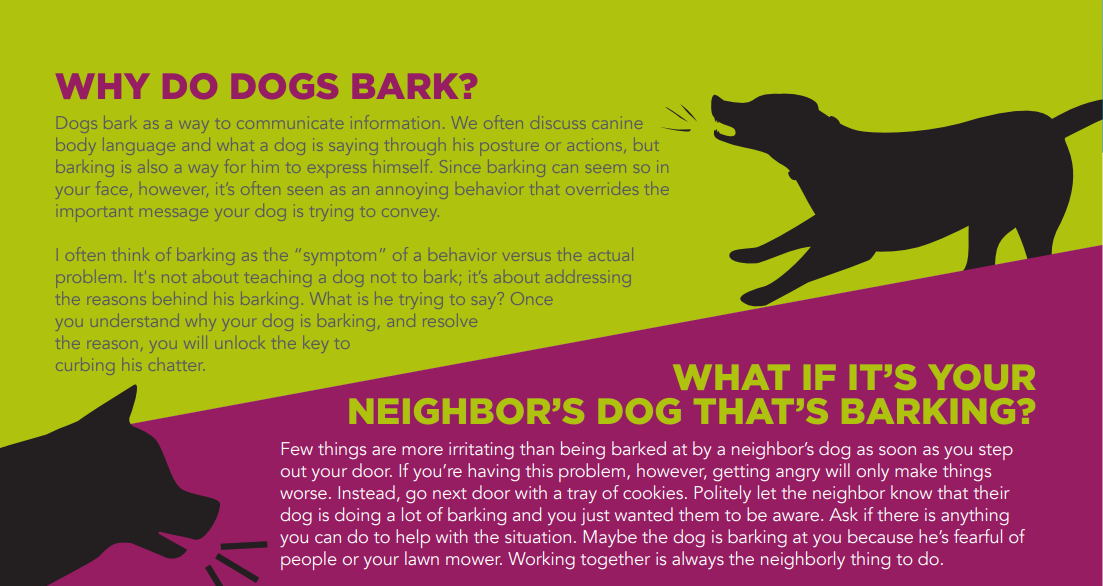Does your dog bark too much?

Dogs bark for many reasons, but if your own pooch is too “talkative”, it’s important to discover why, and find positive ways to curb his barking behavior.
Let’s admit it. Barking dogs can be annoying, not to mention stressful. And when it’s your own dog who’s barking all the time, it can also lead to embarrassment. In some cases, an excessively-barking dog can cause a rift between neighbors and even family members. This article looks at why dogs sometimes bark too much, and what you can do to train this behavior away.
4 common reasons for excessive barking – and how to solve them
1. Separation anxiety or loneliness
Dogs are pack animals and seek companionship. When a dog is left alone for extended periods of time, he can become lonely or even suffer from extreme panic if he has separation anxiety. His barking may even turn to howling. It’s a way to call in his family: “I’m here. I’m alone. Come home.”
What to do
To help your dog feel more secure when you leave him, start teaching him that it’s okay to be alone for short periods.
- Purchase a few new and safe dog chews, toys you can fill with food, and a nice calming CD.
- Fill a toy with something extra special, turn the CD on, and give your dog his new treat-filled toy.
- Tell him, “I’ll be back in a minute.” Then step into another room for a few moments.
- It might take a few trials for your dog to feel comfortable with this new routine. Once he does, extend the time you are in the other room.
- Start changing the room you pop into. During some sessions, step outside. What you are doing is slowly building up the time you are away from your dog, while allowing him to feel safe and secure.
- If your dog has true separation anxiety, please seek the help of your veterinarian and a qualified dog behavior counselor. They will coach you in how to help your dog when your time away is too much for him to bear.
2. Attention-seeking or learned behavior
Dogs are super smart and can learn what works before we even realize what we are teaching them. Attention-seeking barking starts when a dog learns that barking gets you to do something. I typically see this behavior stemming from people who want their dogs to bark to go outside. Sure, you may be teaching your dog to let you know when he needs to use the bathroom, but you are also teaching him that barking gets him things. Personally, I like to teach dogs that being quiet is the road to good things.
What to do
In order to teach your dog that barking for attention does not work, you have to set up the scenario in your favor.
- Make a quick list of all the times your dog barks to get your attention or something else he wants.
- Assuming these are things he can have, such as potty breaks, playtime, or dinner, begin giving him those things before he starts demanding it’s time for them. For example, if your dog asks to go potty four times a day, take him out eight times a day, about a half an hour before he normally asks. If he barks to play, double his play sessions, and once again, play before he normally asks.
- Now that his needs are more than being met, when he asks (because he will at the beginning), just ignore him. Don’t tell him “no,” “lie down,” “leave it,” or anything else. Treat him as if he’s invisible: don’t pay attention to him, don’t look at him. You can even walk away. Eventually, he will learn that barking does not get him what he wants.
- Remember, you are doubling his activities and providing them before he would normally ask for them. If you are doing this, and ignoring the barking for attention, the behavior will eventually extinguish.
3. Alerting
Someone’s here! Something’s not right! Keep in mind that dogs are pack animals, and one of the things they do is alert the pack when there is trouble. A lot of people want to keep this behavior in their dogs. I agree to a point. I feel that a dog can alert us when something is amiss, but then we need to check it out and tell the dog, “It’s fine. No need to worry.”
What to do
- The next time your dog alarm barks, casually go up to him, look at what he’s barking at and tell him your phrase of choice — e.g. “It’s okay,” “Eveything’s all right,” etc.
- Then ask him to come inside with you or into another room. You will likely need to use a tasty treat or new chew toy as a lure.
- He may rush back to the barking area, but just repeat the process. If needed, snap on a leash to keep him with you. Don’t worry – you aren’t rewarding him for barking; you are rewarding him for coming with you.
4. Fear
Fearful barking is a way for your dog to tell the stimulus (person, dog, scary thing) to back off. It’s also a way for him to tell you he needs backup. If you have a fearful dog, it’s important that you manage his environment to ensure he feels safe and secure. In order to teach your dog that the scary thing is not really scary, you need to introduce the stimulus below his fear threshold. In other words, in a way your dog does not see it as a threat.
What to do
The following training process can be used for pretty much any scary stimulus. The key is maintining the correct distance and providing incredibly valuable rewards. If your dog is still exhibiting fear, it’s time to seek the help of a professional.
- If your dog is afraid of men ten feet away, but has no reaction from 20 feet away, then 20 feet is below his threshold and is the distance you will want to maintain between your dog and men.
- When your dog sees a man 20 feet away, pair the sighting with something good, like a meaty treat. In other words, “man at 20 feet = meaty treat.” This process will desensitize your dog and counter-condition him that men at 20 feet predict good things.
- Continue this process until your dog starts to anticipate that men at 20 feet means a reward. When he reaches this point, your next goal is mean at 19 feet, 18 feet, and so on. Slow and steady!
Excessive barking can be an aggravating behavior. Just remember your dog is not trying to be annoying – he’s simply doing his best to convey a message. Don’t try to stop him from communicating. Instead, listen to him, determine why he’s barking, and tackle the problem with positive training techniques.




